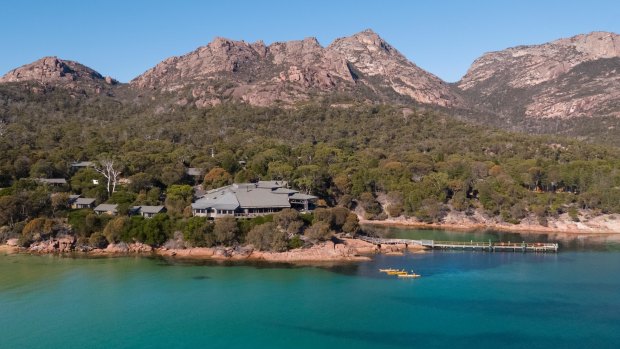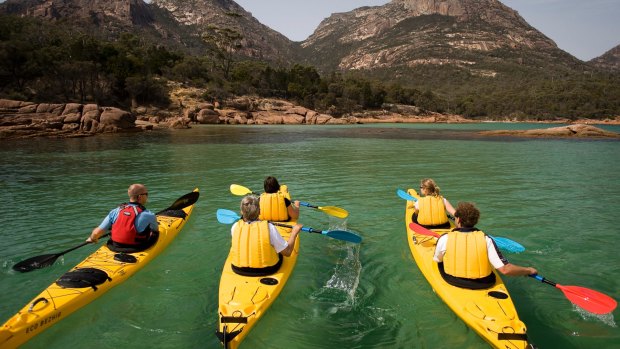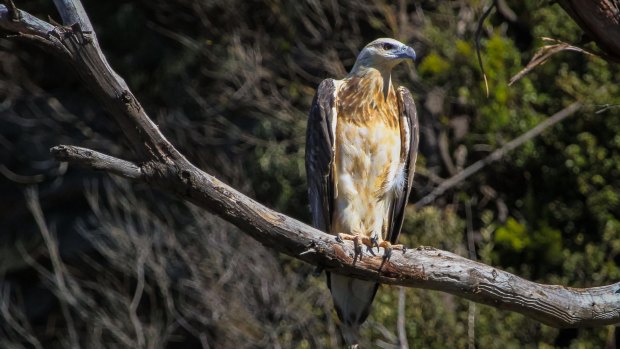This was published 5 years ago
Coles Bay, Freycinet National Park: A paddle beneath Tasmania's stunning, sheer pink mountains
By Jane Reddy

Pink hues: Mountains in Freycinet National Park.
If ever a reminder of one's insignificance in the grander geological scheme of things is required a journey to Tasmania's Freycinet National Park is a must.
I stare up at the Hazards, a collective of granite mountains –Baudin, Dove, Amos and Mayson. This ancient formation is 60 million years of age, give or take, and makes my average life expectancy of 82.5 years, if I'm lucky, a mere blip
The mountains contain vibrant minerals, black micas and white and glossy quartz. But it's the iron oxide impurities of feldspar that give the range its pink hues.

Paddle in Freycinet National Park.Credit: Matthew Newton
So imposing are these mountains, formed following the uplift of blocks of granite from a low range and surface stream erosion, that any existential crises can be put aside just for a moment, to stare at these beauties. And this is exactly what we are doing from a sea kayak with a handful of other paddlers on today's calmish waters of Coles Bay.
We are on a morning paddle with a group of just three adults and three children. Visitors are coming to this region in droves; a record 310,000 were clocked for 2017-18, many headed to the headline attraction of Wineglass Bay for the compulsory selfie from the lookout, stunning vista in the background.
But a floating exploration that starts with the paying of respects to the Toorernomairremener Indigenous people of this region is a delightfully uncrowded experience.

Freycinet Lodge.
Passing the strip of white Richardsons Beach and popular campsites, our guides, Rhia Griffiths and Sia Kanellopoulos, point out dunes and Indigenous middens.
Shellfish such as the angasi oyster and marine vegetables were a crucial food source here and archaeological evidence of these meals and of stone artifacts remain.
It's easy paddling in our twin kayaks gliding over crystalline waters towards the long-established Freycinet Lodge, which is set within the park.

A white-bellied sea eagle is among the wildlife you may encounter at Freycinet National Park.Credit: Kevin Wells / Alamy Stock Photo
We are told of a visit by a pod of dolphins the week before who swam around the group, one jumping over the front of a kayak, as we watch the Wineglass Bay Cruises' 44-foot catamaran nudge the lodge jetty to collect passengers to see the famed lodge from a different perspective.
We bob in the catamaran's wake before motoring on, paddle-powering to Stingray Bay for hot chocolate and Anzac biscuits as we look across waters to Great Oyster Bay beyond, once a site of a thriving whaling industry.
In the early 1800s the southern right whale was hunted, its blubber melted down and sent to England for oil lamps and its bones for corsets, Kanellopoulos says.
"Spotters on tops of hills would send smoke signals, whalers would head out in small boats to harpoon a whale and drag it about the bay until it tired," she says.
It's an uncomfortable thought, 80 or so tonnes of animal bleeding to death. The advent of electricity saw the industry dwindle.
Griffiths directs our gaze upwards to a white-bellied sea eagle sentinel in the tree.
This is not truly an eagle but a giant kite. Its legs are scaled like armour instead of being feathered and it has a wingspan of up to two metres, not to mention spikes in its soles and a hooked beak with which to snatch fish from the surface of the water.
So keen is their vision, one eagle spied a fish at Picnic Island, on the opposite side of Coles Bay, which it promptly flew to and grabbed.
"They mate for life which is really kinda nice," Griffiths says, adding some soft focus to this powerful bird of prey.
Our final pit-stop is the abandoned mine established by the enterprising Italian brothers Mario and Biagio Zanchetta who extracted the pink mineral beauty to make their fortune
The brothers made page seven of Hobart's The Mercury newspaper in 1952 in a story about the pink granite to be used in the new Commonwealth Bank and other buildings in Hobart.
It's also said that the pink made its way into the foyer of the Empire State Building in New York but that's likely a fanciful rumour. In any case, I prefer to see the pink in the solid rock of the Hazards.
TRIP NOTES
Jane Reddy visited as a guest of the Royal Automobile Club of Tasmania (RACT).
MORE
TOUR
The Freycinet Paddle three-hour guided tour departs daily and costs $105 (adult), $95 (children).
Freycinet Adventures offers two-day, fully catered trips in the national park that are also suitable for beginners. Freycinet Aqua Taxi also runs water transport around Freycinet National Park.
Phone 03 6257 0500. See freycinetadventures.com.au
STAY
The RACT-owned Freycinet Lodge is set within the Freycinet National Park. As well as nine coastal pavilions and long-established cabin accommodation, six new mountain terraces opened in August 2018, two of which cater to families. Mountain terraces cost from $429 a night including cooked breakfast.
There is a 25 per cent discount for RACT members and 15 per cent discount for interstate and international auto club members. Phone (03) 6256 7222. See freycinetlodge.com.au
Sign up for the Traveller Deals newsletter
Get exclusive travel deals delivered straight to your inbox. Sign up now.